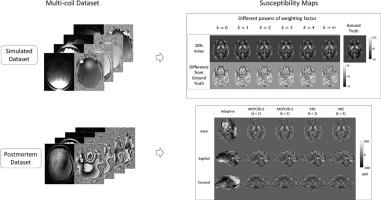Journal of Magnetic Resonance Open Pub Date : 2023-02-05 , DOI: 10.1016/j.jmro.2023.100097 Fábio Seiji Otsuka 1 , Maria Concepcion Garcia Otaduy 2 , José Henrique Monteiro Azevedo 1 , Khallil Taverna Chaim 2 , Carlos Ernesto Garrido Salmon 1

|
Quantitative Susceptibility Mapping (QSM) is an established Magnetic Resonance Imaging (MRI) technique with high potential in brain iron studies associated to several neurodegenerative diseases. Unlike other MRI techniques, QSM relies on phase images to estimate tissue's relative susceptibility, therefore requiring a reliable phase data. Phase images from a multi-channel acquisition should be reconstructed in a proper way. On this work it was compared the performance of combination of phase matching algorithms (MCPC3D-S and VRC) and phase combination methods based on a complex weighted sum of phases, considering the magnitude at different powers (k = 0 to 4) as the weighting factor. These reconstruction methods were applied in two datasets: a simulated brain dataset for a 4-coil array and data of 22 postmortem subjects acquired at a 7T scanner using a 32 channels coil. For the simulated dataset, differences between the ground truth and the Root Mean Squared Error (RMSE) were evaluated. For both simulated and postmortem data, the mean (MS) and standard deviation (SD) of susceptibility values of five deep gray matter regions were calculated. For the postmortem subjects, MS and SD were statistically compared across all subjects. A qualitative analysis indicated no differences between methods, except for the Adaptive approach on postmortem data, which showed intense artifacts. In the 20% noise level case, the simulated data showed increased noise in central regions. Quantitative analysis showed that both MS and SD were not statistically different when comparing and on postmortem brain images, however visual inspection showed some boundaries artifacts on . Furthermore, the RMSE decreased (on regions near the coils) and increased (on central regions and on overall QSM) with increasing . In conclusion, for reconstruction of phase images from multiple coils with no reference available, alternative methods are needed. In this study it was found that overall, the phase combination with is preferred over other powers of .
中文翻译:

对死后人脑定量磁化率作图的多通道相位重建方法的评价
定量磁化率图 (QSM) 是一种成熟的磁共振成像 (MRI) 技术,在与多种神经退行性疾病相关的脑铁研究中具有很高的潜力。与其他 MRI 技术不同,QSM 依靠相位图像来估计组织的相对磁化率,因此需要可靠的相位数据。来自多通道采集的相位图像应该以适当的方式重建。在这项工作中,比较了相位匹配算法(MCPC3D-S 和 VRC)的组合和基于相位复数加权和的相位组合方法的性能,考虑了不同功率的幅度(k = 0 到 4) 作为加权因子。这些重建方法应用于两个数据集:4 线圈阵列的模拟大脑数据集和使用 32 通道线圈在 7T 扫描仪上采集的 22 名死后受试者的数据。对于模拟数据集,评估了基本事实和均方根误差 (RMSE) 之间的差异。对于模拟和尸检数据,计算了五个深部灰质区域的磁化率值的平均值 (MS) 和标准差 (SD)。对于尸检受试者,MS 和 SD 在所有受试者中进行了统计比较。定性分析表明方法之间没有差异,除了对尸检数据的自适应方法显示出强烈的伪影。在 20% 噪音水平的情况下,模拟数据显示中心区域的噪音增加。和在死后大脑图像上,然而目视检查显示一些边界伪影. 此外,RMSE 随着增加而减少(在线圈附近的区域)和增加(在中心区域和整体 QSM). 总之,对于没有可用参考的多个线圈的相位图像的重建,需要替代方法。在这项研究中发现,总体而言,相位组合与优于其他权力.



























 京公网安备 11010802027423号
京公网安备 11010802027423号